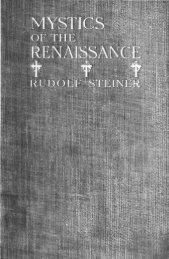The Supreme Doctrine - neo-alchemist
The Supreme Doctrine - neo-alchemist
The Supreme Doctrine - neo-alchemist
Create successful ePaper yourself
Turn your PDF publications into a flip-book with our unique Google optimized e-Paper software.
SENSATION AND SENTIMENT<br />
is in fact a reaction to abnormal images since the formation-centre of these<br />
images is not the real centre of the Universe.<br />
We have clearly distinguished these two emotive responses, to the real<br />
film on the one hand and to the imaginary film on the other. But, with the<br />
human-being after earliest childhood, at no moment does the emotivity<br />
respond only to a real film; an imaginary film is always there at the same<br />
time. <strong>The</strong> emotions are never pure, there is always an emotive state<br />
coexisting, and all the more if the subject is endowed with a need of the<br />
Absolute, with a craving to 'be', with 'idealism'. <strong>The</strong> very young child, in<br />
whom the possibility of inventing an imaginary film does not yet exist since<br />
its intellectual function is insufficiently developed, still has an emotivity that<br />
is nearly pure, quite fluid, without spasm, unstable. But in the degree that the<br />
intellect develops, the spasms of the emotive states appear. With the adult,<br />
very well endowed with a need of the Absolute, the emotivity presents, under<br />
contractions sometimes very unstable, spasms of a slow rhythm; if this man is<br />
well able to observe himself he will recognise this duality of rhythm in his<br />
emotivity. It will seem to him that he has two distinct emotivities, one which<br />
tends to flow and the other to stay put (dreams often contain allusion to this<br />
state of things: I want to move, I need to move, and at the same time I remain<br />
stuck where I am).<br />
<strong>The</strong>re are, then, two kinds of imaginative film, two kinds of emotive<br />
response, and in practice, in our inner phenomenology, two emotivities: one<br />
authentic emotivity in response to the real film, and one illusory or false<br />
emotivity in response to the imaginary film. <strong>The</strong> authentic emotivity<br />
corresponds with the plane of sensation (sense-perceptions of the outer<br />
world), the false emotivity corresponds with the plane of images (imaginary<br />
perceptions). <strong>The</strong> authentic emotivity, that of the child, operates according to<br />
a mobile unstable rhythm and it is quite irrational (it is unrelated with the<br />
importance that our reason accords to the images according to our scale of<br />
values). <strong>The</strong> false emotivity operates with a slow rhythm and it is more or<br />
less rational (except that at moments of fatigue, a certain instability can be<br />
seen there also; but this instability is not a healthy absence of fixity, it is only<br />
failure of a spasm which is exhausting itself). This emotivity is in relation<br />
with the ideal image that I make of the world and of myself, with my desire<br />
to see myself in attitudes that are 'beautiful-good-true' and with my fear of<br />
seeing myself in attitudes that are 'ugly-wicked-false'. My authentic reaction<br />
to a given circumstance scoffs at the 'ideal', it depends only on my vision of<br />
140




